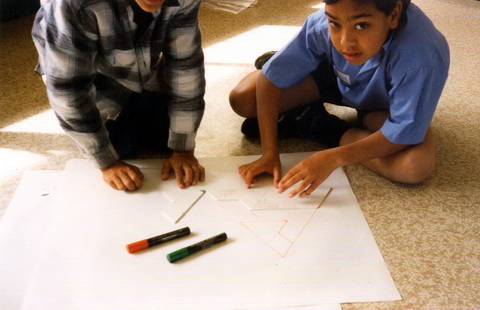Story of the Logo
We are indebted to the Mathematical Association of Victoria for keeping this history on their site from 1998 until 2008.
Can there be a more European task than Task 166, Sphinx? It
derives from the puzzle area of mathematics. These types of puzzles were
prominent in the late nineteenth century when many people had sufficient
spare time to use mathematics as a recreation. Its title refers to classic
Western history, which is sometimes misrepresented as the history
of the human race, thereby potentially demeaning other much older and
longer surviving cultures.
|
 |


|
In the original form of the task, students were given four wooden pieces shaped as shown and challenged to arrange them into a larger 'Sphinx' shape.
As it stands the task is a spatial challenge of moderate difficulty. At
the teaching day in 1996 which initiated the project to trial the Northern Territory Aboriginal Kit in an urban Indigenous situation, two Year 5 Aboriginal and
Torres Strait Islander students, Tyler and Michael from Norris Road
School, accepted the challenge. They solved it quickly, but then, since
all Task Centre tasks represent the tip of an iceberg,
they were challenged to investigate further. |
The solution of the task card problem shows that the base, height and
side lengths of the new Sphinx are twice as long as the corresponding
lengths in a single Sphinx shape. The boys' teacher pointed this out and
asked them to relate this '2 times' information to the fact that the new
Sphinx was made of four original ones.
Suppose we made the base as long as three original Sphinx shapes.
If you could make a new, larger Sphinx how many original Sphinx shapes do
you think you would need? If the '3 times' Sphinx could be made, would all
the side lengths be three times longer than the original?
| The boys now had a new challenge, made all the more difficult by the
fact that only four wooden shapes were available. Their teacher did not
know the answer and, at this stage, did not even know if was possible to
solve this extension of the problem.
The students found a large sheet of paper and set about tracing. This
can be a frustrating approach because, once traced, the drawing can't be
picked up and rotated or reflected like the wooden piece can. But they
persevered. In fact they stuck at the task for about 45 minutes and were
still trying when time ran out.
This teaching day was held at a central location and included students
from several schools. Michael and Tyler had to return to their own school.
They chose to take their incomplete work with them. |

Not the best photo ever taken, but it is the only known record of the moment at which two Aboriginal boys asked, and began answering, a question no one else had asked.
|
Weeks later their solution to this quite difficult task was delivered
to the project organisers. Their solution can be found at this
link, but to appreciate the boys' effort, the reader should first try
the original puzzle and then this extension - for several days!
Significantly the boys had claimed their solution by superimposing a
drawing of the Aboriginal flag on their nine piece solution as in the
logo. This act of leadership stands as testimony to:
- positive personal qualities such as interest, perseverance and
tenacity
- command of mathematical content - in this case pattern, spatial and
measurement concepts and skills
- a high level of mathematical reasoning
- a sense of community
It also pointed the way for other students and teachers to explore
further. For example:
- Was the boys' solution the only '3 times' solution?
- If there is a '2 times' solution and a '3 times' solution, could
there be a '4 times' solution (easy) or a '5 times' solution?
Can there be a more appropriate logo to
support Aboriginal and Torres Strait learners who are taking on the
challenge of western mathematics?

Historic Note
Michael & Tyler's drawing was originally used in the logo of the Mathematics Task Centre Project in this form...
|
|

|

|
|
...and since 2010 it has been the central element of the Mathematics Centre logo in this form.
|
|